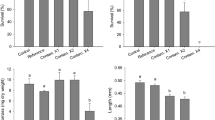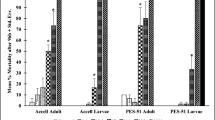Abstract
Oil spills from ship traffic or oil production represent a huge threat to the environment. A controlled and thick oil slick is crucial in relation to combatting oil spills, not least for Arctic waters, before introducing the oil spill response method in situ burning. Recently, herding agents have been introduced, with success, as a measure to contain and thicken oil spills, when sprayed to the perimeter of the slick. In this study, we evaluated potential environmental impacts of using herding agents. Toxicity, bioaccumulation and biodegradability of the two herders ThickSlick 6535 (TS6535) and Siltech OP‐40 (OP‐40) were studied in laboratory set-ups with Arctic water and the high Arctic copepod, Calanus hyperboreus. TS6535 was found to biodegrade rapidly within 7 days, and did not seem to bioaccumulate in the copepods or affect their grazing activity. Tests with OP-40 showed bioaccumulation in the copepods, sublethal effects (as reduced grazing activity) and limited biodegradation. The results thus indicate that OP-40 may possibly pose a risk to the Arctic marine environment. The data and knowledge from the tests poses valuable input to assess the potential environmental impacts from using herders in Arctic waters in connection with oil spill response. However, more knowledge is still needed to fully understand the fate and effect of herders in the environment; this also includes possible combined and/or cumulative effects from herders and oil.
Highlights
-
TS6535 biodegrades within 7 days, whereas OP-40 was only biodegraded within 28 days.
-
TS6535 does not bioaccumulate in Calanus hyperboreus or affect grazing activity.
-
OP-40 tends to bioaccumulate in Calanus hyperboreus and affects grazing activity.





Similar content being viewed by others
Data Availability
The datasets generated and analysed during the current study are available from the corresponding author on reasonable request.
References
Agersted, M. D., Møller, E. F., & Gustavson, K. (2018). Bioaccumulation of oil compounds in the high-Arctic copepod Calanus hyperboreus. Aquatic Toxicology, 195, 8–14.
Brakstad, O. G., Størseth, T. R., Brunsvik, A., Bonaunet, K., & Faksness, L. G. (2018). Biodegradation of oil spill dispersant surfactants in cold seawater. Chemosphere, 204, 290–293. https://doi.org/10.1016/j.chemosphere.2018.04.051
Buist, I. (2010). Field testing of the USN oil herding agent on Heidrun crude in loose drift ice [Internet]. Available from: https://www.sintef.no/projectweb/jip-oil-in-ice/publications/. Accessed 6 Sept 2021
Buist, I., Potter, S., Nedwed, T., & Mullin, J. (2011). Herding surfactants to contract and thicken oil spills in pack ice for in situ burning. Cold Regions Science and Technology [Internet]. [cited 2020 Jan 27];67(1–2),3–23. Available from: https://linkinghub.elsevier.com/retrieve/pii/S0165232X11000383. Accessed 6 Sept 2021
Buist, I.A., Potter, S. G., Trudel, B. K., Shelnutt, S. R., Walker, A. H., Scholz D. K., et al. (2013). In situ burning in ice-affected waters: State of knowledge report.
Buist, I., Cooper, D., Fritt-Rasmussen, J., Wegeberg, S., Gustavson, K., Lassen, P., et al. (2017). Research investigations into herder fate, effects and windows-of-opportunity [Internet]. Available from: http://www.arcticresponsetechnology.org/wpcontent/uploads/2017/09/research-investigations-into-herder-fate_-effects-and-windows-of-opportunity-finalfebruary-1-2017.pdf. Accessed 6 Sept 2021
Bullock, R. J., Perkins, R. A., & Aggarwal, S. (2019). In-situ burning with chemical herders for Arctic oil spill response: Meta-analysis and review. Science of the Total Environment [Internet]. [cited 2020 Jan 28], 675,705–16. Available from: https://linkinghub.elsevier.com/retrieve/pii/S0048969719316535. Accessed 6 Sept 2021
Chapman, P. M., & Riddle, M. J. (2005). Toxic effects of contaminants in polar marine environments. Environmental Science & Technology, 39(9), 200–206.
Cooper, D., Buist, I., & Potter, S. (2017). Experiments at sea with herders and in situ burning (HISB). In: International Oil Spill Conference. p. 1–20.
ECETOC. (1996). Aquatic toxicity testing of sparingly soluble, volatile and unstable substances. Vol. Monograph.
EPI SuiteTM EPI. (n.d.). EPI Suite estimates.
Environment SRERL and D-DC for E and. Reaserch summary: Herding surfactants to contract and thicken oil spills for in situ burning in arctic waters. (2015).
Falk-Petersen, S., Mayzaud, P., Kattner, G., & Sargent, J. R. (2009). Lipids and life strategy of Arctic Calanus. Marine Biology Research [Internet]. [cited 2019 Aug 2],5(1),18–39. Available from: http://www.tandfonline.com/doi/abs/10.1080/17451000802512267. Accessed 6 Sept 2021
Fritt-Rasmussen, J., Brandvik, P. J., Villumsen, A., & Stenby, E. H. (2012). Comparing ignitability for in situ burning of oil spills for an asphaltenic, a waxy and a light crude oil as a function of weathering conditions under arctic conditions. Cold Regions Science and Technology, 72.
Fritt-Rasmussen, J., Gustavson, K., Wegeberg, S., Møller, E. F., Nørregaard, D., Lassen, P., et al. (2017). Ongoing research on herding agents for in situ burning in arctic waters: Studies on fate and effects. In: International Oil Spill Conference Proceedings. p. 1–20.
Fritt-Rasmussen, J., Boertmann, D., Christensen, T., Spelling Clausen, D., Gustavson, K., Wegeberg, S., et al. (2020). Oliespild i grønlandske farvande, miljømæssige udfordringer og beredskab.
Hansen, B. H., Altin, D., Rørvik, S. F., Øverjordet, I. B., Olsen, A. J., & Nordtug, T. (2011). Comparative study on acute effects of water accommodated fractions of an artificially weathered crude oil on Calanus finmarchicus and Calanus glacialis (Crustacea: Copepoda). Science of the Total Environment, 409(4), 704–709.
Møller, E., Maar, M., Jónasdóttir, S., Nielsen, T., & Tönnesson, K. (2012). The effect of changes in temperature and food on the development of Calanus finmarchicus and Calanus helgolandicus populations. Limnology and Oceanography, 57, 211–220.
Nørregaard, R. D., Nielsen, T. G., Møller, E. F., Strand, J., Espersen, L., & Møhl, M. (2014). Evaluating pyrene toxicity on Arctic key copepod species Calanus hyperboreus. Ecotoxicology [Internet]. [cited 2019 Aug 2],23(2):163–74. Available from: http://link.springer.com/10.1007/s10646-013-1160-z. Accessed 6 Sept 2021
Nørregaard, R. D., Gustavson, K., Møller, E. F., Strand, J., Tairova, Z., & Mosbech, A. (2015). Ecotoxicological investigation of the effect of accumulation of PAH and possible impact of dispersant in resting high arctic copepod Calanus hyperboreus. Aquatic Toxicology [Internet]. [cited 2019 Aug 2],167,1–11. Available from: https://linkinghub.elsevier.com/retrieve/pii/S0166445X15300114. Accessed 6 Sept 2021
OECD. (1992). OECD 203 Fish, acute toxicity test. Guidelines for the Testing of Chemicals, 203(1), 1–9.
OECD. (2004). OECD guideline for the testing of chemicals aerobic mineralisation in surface water-simulation biodegradation test.
OSPAR. (2010). OSPAR recommendation 2010/4 on a harmonised pre-screening scheme for offshore chemicals. p. 8.
Rojas-Alva, U., Fritt-Rasmussen, J., & Jomaas, G. (2019). Experimental study of thickening effectiveness of two herders for in-situ burning of crude oils on water (under review). Cold Regions Science and Technology, 175(April), 103083. https://doi.org/10.1016/j.coldregions.2020.103083
Rojas-Alva, U., Fritt-Rasmussen, J., & Jomaas, G. (2020). Small-scale in-situ burning (ISB) experiments with chemically confined crude oils on water. Fire Safety Journal, 1, 114.
Sartz, P., & Aggarwal, S. (2016). Gaseous emissions from herding agent-mediated in-situ burning for Arctic oil spills. In: 39th AMOP Technical Seminar on Environmental Contamination and Response.
Toxværd, K., Dinh, K. V., Henriksen, O., Hjorth, M., & Nielsen, T. G. (2019). Delayed effects of pyrene exposure during overwintering on the Arctic copepod Calanus hyperboreus. Aquatic Toxicology, 217(May), 105332.
van Gelderen, L., Fritt-Rasmussen, J., & Jomaas, G. (2017). Effectiveness of a chemical herder in association with in-situ burning of oil spills in ice-infested water. Marine Pollution Bulletin, 115(1–2), 345–351. https://doi.org/10.1016/j.marpolbul.2016.12.036
Vergeynst, L., Wegeberg, S., Aamand, J., Lassen, P., Gosewinkel, U., Fritt-Rasmussen, J., et al. (2018). Biodegradation of marine oil spills in the Arctic with a Greenland perspective. Science of the Total Environment, 626, 1243–1258.
Vogedes, D., Varpe, Ø., Søreide, J. E., Graeve, M., Berge, J., & Falk-Petersen, S. (2010). Lipid sac area as a proxy for individual lipid content of arctic calanoid copepods. Journal of Plankton Research, 32(10), 1471–1477.
Wegeberg, S., Fritt-Rasmussen, J., & Gustavson, K. (2020). AU environment & oil spill response (EOS) an analytic tool for environmental assessments to support oil spill response planning. The Handbook.
Acknowledgements
Ellen Christiansen and Charlotte Dahl Schiødt for assistance in the laboratory completing the chemical analysis, Daniel Spelling Clausen for assistance with preparing the map, and Mads Schultz for assistance in the laboratory.
Funding
This work was supported by the International Oil and Gas Association IOGP, the Arctic Oil Spill Response Technology Joint Industry Programme (JIP), and DCE, the Danish Centre for Environment and Energy.
Author information
Authors and Affiliations
Corresponding author
Additional information
Publisher's Note
Springer Nature remains neutral with regard to jurisdictional claims in published maps and institutional affiliations.
Rights and permissions
About this article
Cite this article
Fritt-Rasmussen, J., Møller, E.F., Kyhn, L.A. et al. Biodegradation, Bioaccumulation and Toxicity of Oil Spill Herding Agents in Arctic Waters as Part of an Ecotoxicological Screening. Water Air Soil Pollut 232, 380 (2021). https://doi.org/10.1007/s11270-021-05332-8
Received:
Accepted:
Published:
DOI: https://doi.org/10.1007/s11270-021-05332-8




